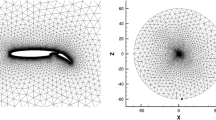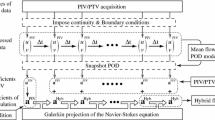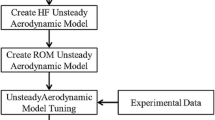Abstract
A new hybrid approach to constructing reduced-order models (ROM) of unsteady aerodynamics applicable to aeroelastic analysis is presented by using proper orthogonal decomposition (POD) in combination with observer techniques. Fluid modes are generated through POD by sampling observations of solutions derived from the full-order model. The response in the POD training is projected onto the fluid modes to determine the time history of the modal amplitudes. The resulting data are used to extract the Markov parameters of the low-dimensional model for modal amplitudes using a related deadbeat observer. The state-space realization is synthesized from the system’s Markov parameters that are processed with the eigensystem realization algorithm. The POD-observer method is applied to a two-dimensional airfoil system in subsonic flow field. The results predicted by the ROM are in general agreement with those from the full-order system. The ROM obtained by the hybrid approach captures the essence of a fluid system and produces vast reduction in both degrees of freedom and computational time relative to the full-order model.
Similar content being viewed by others
References
Hall K C, Thomas J P, Dowell E H. Proper orthogonal decomposition technique for transonic unsteady aerodynamic flows. AIAA J, 2000, 38: 1853–1862
Dowell E H, Thomas J P, Hall K C. Transonic limit cycle oscillation analysis using reduced order aerodynamic models. J Fluids Struct, 2004, 19: 17–27
Hay A, Akhtar I, Borggaard J T. On the sensitivity analysis of angle-of-attack in a model reduction setting. 2010, AIAA Paper 2010-1473
Ghommem M, Akhtar I, Hajj M R, et al. A reduced-order model for unsteady flow over circular cylinder. 2010, AIAA Paper 2010-1275
Cowan T J, Arena A S, Gupta K K. Development of a discrete-time aerodynamic model for CFD-based aeroelastic analysis. 1999, AIAA Paper 99-0765
Gupta K K, Voelker L S. CFD-based aeroelastic analysis of the X-43 hypersonic flight vehicle. 2001, AIAA Paper 2001-0712
Zhang W W, Ye Z Y. Transonic aeroelastic analysis basing on reduced order aerodynamic models (in Chinese). Chin J Comput Mech, 2007, 24: 768–772
Silva W A. Reduced-order models based on linear and nonlinear aerodynamic impulse responses. 1999, AIAA Paper 1999-1262
Raveh D E, Levy Y, Karpel M. Efficient aeroelastic analysis using computational unsteady aerodynamics. J Aircraft, 2001, 38: 547–556
Xu M, Li Y, Zeng X A, et al. Volterra-series-based reduced-order model for unsteady aerodynamics (in Chinese). Struct & Environ Eng, 2007, 34: 22–28
Chen G, Xu M, Chen S L. Reduced-order model based on volterra series in nonlinear unsteady aerodynamics (in Chinese). J Astron, 2004, 25: 492–495
Wu Z G, Yang C. Volterra series based transonic unsteady aerodynamic modeling (in Chinese). J Beijing Univer Aeron Astron, 2006, 32: 373–376
Balajewicz M, Nitzsche F, Feszty D. On the application of multi-input volterra theory to nonlinear multi-degree-of-freedom aerodynamic systems. 2008, AIAA Paper 2008-2324
Thomas J P, Dowell E H, Hall K C. Three-dimensional transonic aeroelasticity using proper orthogonal decomposition based reduced order models. 2001, AIAA Paper 2001-1526
Cowan T J, Arena A S, Gupta K K. Accelerating computational fluid dynamics based aeroelastic predictions using system identification. J Aircraft, 2001, 38: 81–87
Silva W A, Raveh D E. Development of unsteady aerodynamic state-space models from CFD-based pulse reponses. 2001, AIAA Paper 2001-1213
Lucia D J, Beran P S. Reduced-order model development using proper orthogonal decomposition and volterra theory. AIAA J, 2004, 42: 1181–1190
Lucia D J, Beran P S, Silva W A. Aeroelastic system development using proper orthogonal decomposition and volterra theory. 2003, AIAA Paper 2003-1922
Juang J N, Phan M, Horta L G, et al. Identification of observer/kalman filter markov parameters: theory and experiments. J Guid, Contr, Dynam, 1993, 16: 320–329
Phan M, Horta L G, Juang J N, et al. Linear system identification via an asymptotically stable observer. J Optim Theor Appl, 1993, 79: 59–86
Valasek J, Chen W. Observer/kalman filter identification for online system identification of aircraft. J Guid, Contr, Dynam, 2003, 26: 347–353
Kim T. An efficient response-based modal analysis for dynamic system with multiple inputs. 2001, AIAA Paper 2001-1380
Juang J N, Pappa R S. An eigensystem realization algorithm for modal parameter identification and model reduction. J Guid, Contr, Dynam, 1985, 8: 620–627
Davis S S. Naca64a010 Oscillatory Pitching, in Compendium of Unsteady Aerodynamics Measurements. Tech Rep AGARD-R-702, 1982
Won K S, Tsai H M, Ray T, et al. Flutter simulation and prediction via identification of non-linear impulse response. 2005, AIAA Paper 2005-834
Author information
Authors and Affiliations
Corresponding author
Rights and permissions
About this article
Cite this article
Yang, C., Liu, X. & Wu, Z. Unsteady aerodynamic modeling based on POD-observer method. Sci. China Technol. Sci. 53, 2032–2037 (2010). https://doi.org/10.1007/s11431-010-3178-2
Received:
Accepted:
Published:
Issue Date:
DOI: https://doi.org/10.1007/s11431-010-3178-2




